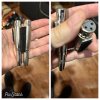
Do use an adapter so you can use any guitar cable lying around.What is the actual cable? For example ‘Mogami W2549’?
I don’t know that most (any?) manufacturers distinguish their ‘2-conductor plus shield’ cabling as being designed for mic cabling or for line level (and I suspect none market it for instrument level, since instrument cabling is typically 1-conductor plus shield).
In any event, if you are running output1 into a balanced input with a TRS plug any quality XLR->TRS cable should work fine.
If you are running output1 into an unbalanced input, then XLR->TS is fine (using TRS is unnecessary as it’s not balanced anyway …).
You can’t do a balanced connection with a standard guitar cable though. Whether that’s relevant depends on your setup (including whether you’re plugging into a device with balanced inputs …).Do use an adapter so you can use any guitar cable lying around.
.
Yes.Can I use XLRf-TRSm MICROPHONE cable on Output 1?
They're actually not different.I know INSTRUMENT cable and MICROPHONE cable are not the same but its so hard to find XLRf-TRSm INSTRUMENT cable with long length.
I've got some of those in my FM3 case and it's saved my bacon a couple of times. Last week I was playing a gig and we needed to mic an upright piano in a pinch with no PA available and I was able to run the mic into Input 2 on the FM3 and process it (FET Preamp in the Drive block worked great!) because I had one of those XLR adapters. My XLR-TS cables haven't failed me yet, but in case they do, I'd be able to convert any standard guitar cable for use with the FM3 with those adapters.Yes, you can. You can use an XLR to TS (1/4" mono) and plug it into any amp. I keep two of these doohickeys on my pedalboard just in case I find myself having to disable the cab and / or amp block and plug into an amp. Don't use it often, but I'm glad I have these when I do. Alternately, you can have output 2 be that same as output 1 and use those 1/4" outputs.
View attachment 112957
Precisely!I've got some of those in my FM3 case and it's saved my bacon a couple of times. Last week I was playing a gig and we needed to mic an upright piano in a pinch with no PA available and I was able to run the mic into Input 2 on the FM3 and process it (FET Preamp in the Drive block worked great!) because I had one of those XLR adapters. My XLR-TS cables haven't failed me yet, but in case they do, I'd be able to convert any standard guitar cable for use with the FM3 with those adapters.
Digital XLR cables (e.g., AES or DMX) are different. But, they also work for Mic and Line.
I'm pretty sure mine are HOSA.What brands you using for XLR to TS ? I can only find a few like Hosa and Livewire
Really, just ohms. Usually 1MΩ
